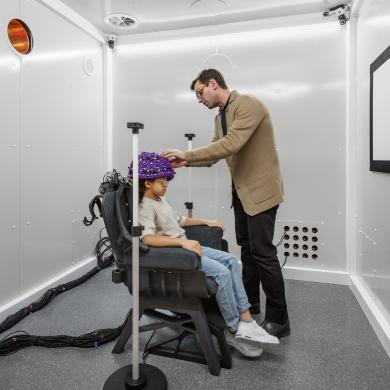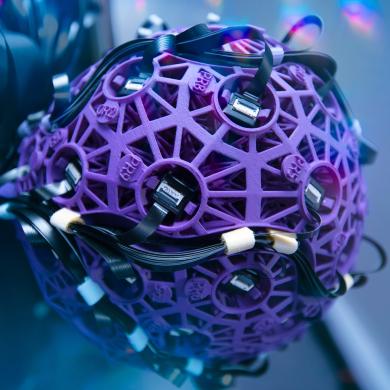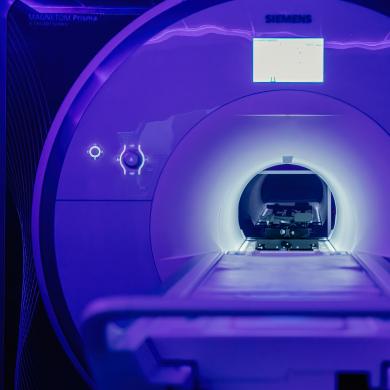BrainWorks
Safe technologies for cutting-edge studies of human brain function
Research on the healthy human brain is limited, for ethical and health reasons, to looking from the outside in. There are now several remarkable technologies that can measure activity across the whole brain at the level of regions and networks. BrainWorks, one of the Wu Tsai Institute’s core facilities operated by the Center for Neurocognition and Behavior, makes these safe and repeatable technologies available to researchers for cutting-edge studies of human brain function.
BrainWorks is located on the first floor of 100 College Street, with a dedicated entrance at the back of the building easily accessible to research participants. It is designed to encourage and honor a partnership between the humans conducting the studies and the humans participating in the studies.



The humanity of researchers and participants is placed at the fore in a welcoming environment that promotes comfort, fun, curiosity, and learning.
Groundbreaking and illuminating studies are conducted with the entire span of human participants, from infants and toddlers, through children and adolescents, to young and older adults. These studies contribute to fundamental advances in our understanding of the human brain and behavior. Through their participation, participants come away from the experience inspired and informed about their own brains and lives.
Equipment
Technologies for studying the human brain in action are advancing rapidly. BrainWorks will house all existing human neurotechnologies and will continually add new tools when they become available. BrainWorks is available for use by Wu Tsai Faculty Members and their trainees. Join the BrainWorks mailing list for updates, and invitations to our events and user meetings.
Magnetic Resonance Imaging (MRI)
- 3 Tesla magnetic field 20-channel, 32-channel, and 64-channel head and head/neck coils
- Maximum amplitude of 80 mT/m @ a slewrate of 200 T/m/s
- Sequences for rapid, high-resolution functional, structural, diffusion weighted, susceptibility weighted, and quantitative imaging
- OptoAcoustics OptoActive III adult and newborn headset with active noise cancellation for high fidelity audio delivery at high frequencies
- OptoAcoustics fiber optic microphone with active noise cancellation
- PST Hyperion projector system, 1080p@60 Hz
- SR Research EyeLink 1000+ eye tracker
- BIOPAC MP160 with EDA module
- A range of fiber optic response boxes
- PST Vera MRI simulator
- Realistic 60 cm bore and 32-channel head coil
- Real time head movement measurement
- Simulates the acoustic environment of the MRI Screen and trainer response boxes
Magnetoencephalography (MEG)
- 306-channel system
- Simultaneous 32-channel EEG
- Simultaneous EOG, ECG, EMG recording (up to 16 bipolar signals)
- Polhemus electromagnetic digitizer for co-registration
- Housed in a 4 x 3 m2 magnetically shielded room
- ProPixx projection system (1080p @ 120 Hz)
- Pneumatic earphone system
- A range of fiber optic response boxes SR
- Research EyeLink 1000+ eye tracker
- 64 triaxial QZFM Gen-3 sensors (192 channels)
- Housed in a 2.4 x 2.8 m2 magnetically shielded room with active shielding
- 1080p @ 60 Hz projection system
- Free field stereo audio
- A range of fiber optic response boxes
Electroencephalography (EEG)
- For in-lab use
- Simultaneous eye tracking with the EyeLink 1000+
- Simultaneous EOG, ECG, EMG, EDA, and respiration recording (up to 8 channels)
- Network-based event marking and real-time data access over Lab Streaming Layer
- Maximum 100,000 Hz sampling rate (DC-coupled 7,500 Hz bandwidth)
- 32 or 64-channel EEG and up to 8 auxiliary channels
- Pocket sized wireless amplifier for mobile EEG applications
- Maximum 1,000 Hz sampling rate
- Available as two 32-channel amplifiers or one 64-channel amplifier
- Wireless network-based event marking and real-time data access over Lab Streaming Layer, or record to SD card
- Addon sensor extension module for simultaneous EOG, EMG, ECG, EDA, and respiration recording
Functional near-infrared spectroscopy (fNIRS)
Comfortable EasyCaps provide 10-20 scalp coverage in sizes from infants to adults. In-lab recordings can be integrated with eye tracking using EyeLink 1000+ systems in head-fixed or remote mode.
Two 16x16 NIRx NIRSport 2 systems are available, which can be combined into one 32x32 system.
- Sampling rate up to 240 Hz
- Wireless network-based event marking and real-time data access over Lab Streaming Layer, or record to builtin storage
- Simultaneous EOG, ECG, EMG, EDA, SpO2 and respiration recording
- Wireless network-based event marking and real-time data access over Lab Streaming Layer, or record to device
Motion capture and immersive lab
Pico Neo3
- 5.5” 3664 x 1920 resolution display
- Qualcomm® Snapdragon™ XR2 Platform
- 6 GB RAM, 256 GB storage
- Refresh rate between 72 Hz and 90 Hz
Pupil Labs Core Eye Tracker
- Dark pupil technique + 3D modeling used for tracking
- Binocular or monocular eye-tracking
- 0.60° accuracy and 0.02° precision
- Scene camera: 1080p @ 30 Hz, 720p @ 60 Hz, 480p @ 120 Hz
- Eye cameras: 2 x IR cameras, 192 x 192 px @ 200 Hz
- 16’ x 15’ x 8’ acoustically dampened capture volume
- 12 OptiTrack PrimeX 22 cameras
- Records at 360 fps natively, 500+ fps maximum
- +/- 0.15 mm 3D accuracy, <0.5° rotational errors
- 2.2 MP resolution
- Passive IR reflective markers
- Motive 3.0 program for acquiring data
- Data can also streamed, in real time, to other devices on the BrainWorks network
Transcranial magnetic stimulation (TMS)
- Biphasic, monophasic, and half-sine waveforms
- Highly customizable stimulation patterns, up to 100 Hz
- ~180 A/μs peak di/dt
- Trigger interfaces allow precise synchronization between stimulus presentation and stimulation
- Integrated motor evoked potential recording
- High performance liquid cooling system
- Localite neuronavigation system




